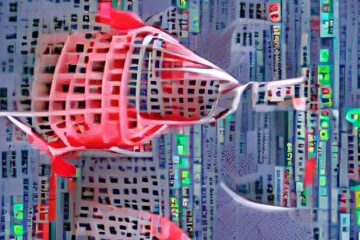Web3 touts a decentralized future for the internet, with users as owners, where power is transferred back to the community and away from the current guard. But just because we could potentially do this, doesn’t mean it will happen. Web3 technologies will invariably be deployed against the backdrop of our currently entrenched systems. Recall, technology during the industrial revolution had a wide-span of outcomes, as it was used quite differently across a variety of international contexts.
And, perhaps unsurprisingly, we’ve heard this song before. In fact, the “I’m bringing you salvation” hymn coming out of Silicon Valley and enforced by their economically-incentivized VCs feels endemic. Historically, these promises involve decentralizing access to services, while centralizing wealth and control (recall Microsoft, Facebook, Apple). Web3, as it currently stands, is no different.
The future will not be a less, but a more magnified version of the techno-capitalist feudalism that we live in today.
In 2032, I foresee Web3 failing to bring about its promise of a more egalitarian and decentralized state of the world, and instead leading to a continued centralization of power into even fewer hands. The future will not be a less, but a more magnified version of the techno-capitalist feudalism that we live in today.
Web3’s Current Red Flags, Its Inevitable Coordination & Operational Hurdles
The shortcomings of Web3 today, relative to its promises. See investors, builders, and coin centralization.
Investors
Jack Dorsey put it best by tweeting, “The people do not own Web3, VC and their LPs do”. . . and he’s right. VC bets on Web3/crypto startups grew over 25-fold in 2021. With the largest investors (Sequoia, Tiger, Andreesen) all participating. A16z has raised a $2.2B crypto fund – investing in companies like Opensea, DapperLabs, crypto wallet-maker Phantom and the blockchain Solana.
Unsurprisingly it’s investing in platforms that feature monopolistic power and have the potential to centralize wealth. Over $20B in crypto funds have been raised in the LTM by VCs. Assuming blended 10x returns this implies a $2T market cap over ~5-10 years. Analysis by Portal Ventures suggests this means $800B+ in float capital required that cannot be absorbed by retail and will require institutional capital (alternative asset AUM) – so the same institutions that govern today’s economy.
Builders
The builders are, well, who you’d expect. Crypto-billionaires look oddly familiar. Every member on the Forbes 2021 list is a man. All except 1 are white, and 1/3 attended Stanford or Harvard. Recall the BrainTRUST case. The early participants were the Ex-Instagram CTO, a Stanford grad, TaskRabbit CEO – all Silicon Valley insiders. And now well-capitalized Corporations are hopping in — as the majority of the world fumbles around setting up a wallet, Corporations are establishing their presence. Companies hiring for crypto jobs include NFL, Nike, Hulu, VISA, Meta, Apple, Nvidia, Disney, Paypal, Google, Fidelity, Amazon, Microsoft, JPM, Mastercard, Goldman Sachs, Bank of America, to name a few
Coin centralization
We heard it directly from Silvio Micali of Algorand (amongst others) that blockchains are “not really decentralized.” 80% of the NFT Market (on Eth) are owned by ~9% of accounts, and ~95% of Bitcoin is owned by ~2% of accounts And if you think that’s simply a relic of the past, analysis run by Tomasz Tunguz on major crypto projects suggests the insider ownership share at launch has been increasing not decreasing overtime.
So we have the same investors, the same builders, focused on ideas with monopolistic potential, who are getting an outsized share of the pie by getting in early, and that share grows disproportionately over time.
Crypto itself has a lot of dystopian potential if implemented wrong” and “If we don’t exercise our voice the only things that get built are what is immediately profitable, and those are often far from what’s actually best for the world.”
Vitalik Buterin
The Coordination and Operational Frictions That Prevent Us from Achieving Web3’s Panglossian Potential
DAOs will inevitably embrace less distributed governance structures, since expertise, accountability, and efficiency matter. Tyler Ward acknowledged this, saying “True democracy has never really worked . . . . Ultimately we will need DAOs to be governed.” Founder of Lido DAO Konstantin Lomashuk further recognized “We don’t have any good examples of how to manage a DAO.” Giving Web3 a bit of an out adding “We’re doing something new, and it’s difficult.”
But this isn’t new, DAOs are learning real time what history has taught us over time – that it’s hard to corral human beings – org structures have been put in place throughout civilization to optimize mobilization against any type of action or decision, whether it be war or what interest rate to plug into your excel model.
Thus those with expertise, typically take on decision-making rights for the many. But as those decision-makers amass more credibility and more tokens, eventually, as Aave Founder Stani Kulechov said “major stakeholders control the vote.” Overtime then, by pursuing effectiveness, DAOs will gravitate to what increasingly resembles traditional org structures of public companies
Middlemen will predictably be required for most people to operate in Web3
Current infrastructure is already being built on the existence of middlemen – many decentralized apps, rely on ‘ETH nodes as a service’ applications such as Infura, Alchemy, and Moralis in order to function. Additionally, since (similar to internet 1.0) operating in the blockchain is clunky and difficult, platforms are being created to help individuals participate in these markets.
Some of these platforms, like Coinbase and Opensea, act as Web2 bridges and fix the user-experience issues and trust issues that come with a decentralized system. But even embedded within Web3, middleware protocols are built between the blockchain layer and the DApps themselves (i.e. RPC layers, front-end layers) that all charge fees.
“The rules are set by the people that show up.”
Alexis Borisy
So middlemen are replaced with middleware, and instead of equity holders extracting value its developers who build the protocol – but the rent-seeking structure remains. This is why I hypothesize Web3 to inevitably follow the same path as Web1 did to Web2 – with the ensuing construction of org structures and usage of middlemen for efficiency. Web3 will be Web4, which is effectively Web2.1.
Probability Distribution
Directionally, I believe the probability distribution of the future as a function of Web3 is as follows: 40% chance the world maintains similar inequality, 50% chance the world becomes more unequal, 10% chance it leads to more socio-economic equality in our society.
We, as the next generation of business leaders, can choose to act differently and shape the future. . . the problems Web3 aims to solve are people problems, man-made, that require human decision-making to fix them.
Why This Matters and Steps for Mitigation
While the aforementioned most likely leads to a state of the world where inequality continues to be exacerbated, it does not have to be the case. We, as the next generation of business leaders, can chose to act differently and shape the future. And that’s why this analysis is important. Because the problems Web3 aims to solve are people problems, man-made, that require human decision-making to fix them.
The narrative that the technology will save us is dangerous because it convinces people that we do not need to act differently or think differently. The technology alone is not our savior, if our actions and our motivations do not change from the actions and motivations that brought about the errs in our current system. Web3 provides us an opportunity for a different future, but it is far from guaranteed.
Founder of ETH Vitalik Buterin shares this concern, “Crypto itself has a lot of dystopian potential if implemented wrong” and “If we don’t exercise our voice the only things that get built are what is immediately profitable, and those are often far from what’s actually best for the world.” Recall what Alexis Borisy of EQRx said, “the rules are set by the people that show up.” So consider this a call to action for us to use our voice, get involved, and make some hard decisions – principally, solving for variables beyond short-term profit.
Investors
We can deliberately mobilize communities over taking VC capital, increasing the value exposure for community actors vs capital allocators. As investors, invest consciously in projects leveraging Web3 to solve challenging global problems vs quick profit schemes.
Builders
As builders, we can sacrifice some of our personal financial upside for the sake of our workers, rewarding those that keep our organization functioning more fairly, and developing competitive moats through attracting talent and being a great place to work vs. exploitation
Coin centralization
We can favor access over elitism – specifically considering this when creating the distributive functions associated with our tokenomics
Governance
Efforts need to be made to make communications and decision making rights more accessible through increased tooling – investing in the participation of communities over the expeditious nature of proposals, ultimately doing what’s right over what’s easy.
Middlemen
Given the inevitability, proactively manage the balance of value creation vs value extraction, and be prepared and willing to mobilize when negative externalities become pervasive.
If we want to create real change, these problems aren’t resolved by bits on the blockchain, but by human actions driven by empathy, fairness, and understanding. And so if we want Web3 to truly usher in a better system, instead of simply changing the flavor of our current techno-capitalist feudalism, then we need to make some hard decisions.
Final Thoughts
To conclude, I’m not suggesting that Web3 will not change our day-to-day lives, it will. But the fundamental proposition, the mission, of a more utopian egalitarianism system will not occur. Since “the world runs by way of money” (TMOTF) and “the gods in the system are the accountants” (Ghosh), the promised institutional change will not happen unless we as the business leaders of tomorrow begin praying to different gods. And we won’t, as every snowflake pleads not guilty in an avalanche.
Andrew Kosc has worked primarily in consulting and tech, at Bain & Co & Alphabet (YouTube and X, the Moonshot Factory). Remaining a generalist to this point, while providing him no discernable skills, has at least enabled a level of sobriety in his analysis of businesses, markets, and the future. A big believer in what the bonds of empathy can accomplish, he is also aware of how susceptible humans are to incentives.




0 Comments